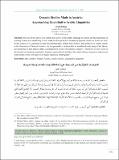Files in this item
Quranic studies made in Austria : approaching quantitative Arabic linguistics
Item metadata
| dc.contributor.author | Elmaz, Orhan | |
| dc.date.accessioned | 2020-06-22T10:30:02Z | |
| dc.date.available | 2020-06-22T10:30:02Z | |
| dc.date.issued | 2020-07 | |
| dc.identifier | 266559800 | |
| dc.identifier | e8d13654-bfe1-4784-99fa-ae1130a37e1e | |
| dc.identifier | 000572885600008 | |
| dc.identifier.citation | Elmaz , O 2020 , ' Quranic studies made in Austria : approaching quantitative Arabic linguistics ' , Journal of College of Sharia and Islamic Studies , vol. 38 , no. 1 , pp. 159-175 . https://doi.org/10.29117/jcsis.2020.0261 | en |
| dc.identifier.issn | 2523-1715 | |
| dc.identifier.other | ORCID: /0000-0002-7319-6628/work/76387008 | |
| dc.identifier.uri | https://hdl.handle.net/10023/20118 | |
| dc.description.abstract | The aim of this article is to outline the interest in the Arabic language in Europe and the beginnings of teaching Arabic and establishing Arabic Studies in Europe, before introducing Quranic Studies in Austria as such. In this context is important to note that unfortunately neither Arne Ambros, late professor of Arabic Studies at the University of Vienna in Austria, nor the quantitative methods that he introduced to the study of the Quran are mentioned in Sāsī Sālim al-Ḥāj’s comprehensive review of Orientalist studies . Therefore, in order to show some of the benefits of adopting quantitative linguistic approaches, I will introduce the study of hapax legomena and will present some results of my own analysis of hapax legomena in the Quran | |
| dc.format.extent | 17 | |
| dc.format.extent | 504472 | |
| dc.language.iso | eng | |
| dc.relation.ispartof | Journal of College of Sharia and Islamic Studies | en |
| dc.subject | Arne Ambros | en |
| dc.subject | Vienna (Austria) | en |
| dc.subject | Arabic studies | en |
| dc.subject | Quantitative linguistics | en |
| dc.subject | AZ History of Scholarship The Humanities | en |
| dc.subject | PI Oriental languages and literatures | en |
| dc.subject | T-NDAS | en |
| dc.subject.lcc | AZ | en |
| dc.subject.lcc | PI | en |
| dc.title | Quranic studies made in Austria : approaching quantitative Arabic linguistics | en |
| dc.type | Journal article | en |
| dc.contributor.institution | University of St Andrews. Arabic and Persian | en |
| dc.identifier.doi | https://doi.org/10.29117/jcsis.2020.0261 | |
| dc.description.status | Peer reviewed | en |
This item appears in the following Collection(s)
Items in the St Andrews Research Repository are protected by copyright, with all rights reserved, unless otherwise indicated.

